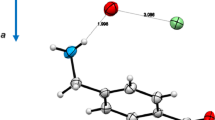Abstract
This paper describes the X-ray crystal structure of a complex of acridono-18-crown-6 ether 3 and lead(II) perchlorate. The structure shows a π–π bonded heterodimer in the crystal. One part of the dimer moves to 9-hydroxyacridine tautomeric form upon lead(II) complexation, in which the lead(II) ion is eight-coordinated and fits well into the cavity of the macrocycle. The other part of the dimer stays in the 9(10H)-acridone tautomeric form, which favors water complexation. The average bond distance of the two tricyclic units (3.5 Å) indicates a strong π–π interaction. The X-ray studies also revealed a cation–π interaction between lead(II) and the electron-rich acridone moiety.




Similar content being viewed by others
References
Ovchinnikov YA (1979) Physico-chemical basis of ion transport through biological membranes: ionophores and ion channels. Eur J Biochem 94:321–336
Hunter CA, Sanders JKM (1990) The nature of π–π interactions. J Am Chem Soc 112:5525–5534
Anslyn EV, Dougherty DA (2005) In: Murdzek J (ed) Modern physical organic chemistry. University Science Books, Sausalito
Pecsi I, Leveles I, Harmat V, Vertessy BG, Toth J (2010) Aromatic stacking between nucleobase and enzyme promotes phosphate ester hydrolysis in dUTPase. Nucleic Acids Res 38:7179–7186
Mahadevi AS, Sastry GN (2013) Cation−π interaction: its role and relevance in chemistry, biology, and material Science. Chem Rev 113:2100–2138
Nagy GN, Marton L, Contet A, Ozohanics O, Ardelean LM, Révész A, Vékey K, Irimie FD, Vial H, Cerdan R, Vértessy BG (2014) Composite aromatic boxes for enzymatic transformations of quaternary ammonium substrates. Angew Chem Int Ed Engl 53:13471–13476
Desvergne JP, Czarnik AW (eds) (1997) Chemosensors of ion and molecule recognition NATO ASI Series C. Kluwer, Dordrecht 492
Grant LD (2009) In: Lippmann M (ed) Lead and compounds. Environmental toxicants: human exposures and their health effects, 3rd edn. Wiley, Hoboken. Wiley-Interscience
Needleman H (2004) Lead poisoning. Annu Rev Med 55:209–222
Dapul H, Laraque D (2014) Lead poisoning in children. Adv Pediatr 61:313–333
Bazzicalupi C, Bencini A, Fusi V, Giorgi C, Paoletti P, Valtancoli B (1999) Lead complexation by novel phenanthroline-containing macrocycles. J Chem Soc Dalton 3:393–400
Aguilar JC, de San Miguel ER, de Gyves J, Bartsch RA, Kim M (2001) Design, synthesis and evaluation of diazadibenzocrown ethers as Pb2+ extractants and carriers in plasticized cellulose triacetate membranes. Talanta 54:1195–1204
Esteban D, Avecilla F, Platas-Iglesias C, Mahía J, de Blas A, Rodríguez-Blas T (2002) Lead(II) complexes with macrocyclic receptors derived from 4,13-diaza-18-crown-6. Inorg Chem 41:4337–4347
Esteban D, Avecilla F, Platas-Iglesias C, de Blas A, Rodríguez-Blas T (2003) Synthesis and structural characterisation of lead(II) isothiocyanate complexes with receptors derived from 1,10-diaza-15-crown-5. Polyhedron 22:2709–2717
Grzegorzewski P, Nikonowicz A, Jurczak J (2004) Complexation of Pb2+ by macrocyclic benzo- and pyridinophanes. J Incl Phenom 49:97–100
Lee SH, Kim JY, Kim SK, Lee JH, Kim JS (2004) Pyrene-appended calix[4] crowned logic gates involving normal and reverse PET: NOR, XNOR and INHIBIT. Tetrahedron 60:5171–5176
Buschmann HJ, Schollmeyer E (2010) Stability constants and thermodynamic data for the complexation of Pb2+ by noncyclic, macrocyclic and macrobicyclic ligands in aqueous solution. J Coord Chem 55:287–291
Farina P, Latter T, Levason W, Reid G (2013) Lead(II) tetrafluoroborate and hexafluorophosphate complexes with crown ethers, mixed O/S- and O/Se-donor macrocycles and unusual [BF4]− and [PF6]− coordination. Dalton T 42:4714–4724
Szalay L, Farkas V, Vass E, Hollósi M, Móczár I, Pintér Á, Huszthy P (2004) Synthesis and selective lead(II) binding of achiral and enantiomerically pure chiral acridono-18-crown-6 ether type ligands. Tetrahedron Asymmetry 15:1487–1493
Németh T, Kormos A, Tóth T, Balogh G, Huszthy P (2015) Synthesis and cation binding of acridono-18-crown-6 ether type ligands. Monatsh Chem 146:1291–1297
Huszthy P, Köntös Z, Vermes B, Pintér Á (2001) Synthesis of novel fluorescent acridono- and thioacridono-18-crown-6 ligands. Tetrahedron 57:4967–4975
CrysAlisPRO (2011) Oxford diffraction. Agilent Technologies UK Ltd, Yarnton
Dolomanov OV, Bourhis LJ, Gildea RJ, Howard JAK, Puschmann H (2009) OLEX2: a complete structure solution, refinement and analysis program. J Appl Cryst 42:339–341
Sheldrick GM (1997) SHELX97, programs for crystal structure analysis. University of Gottingen, Gottingen
Huszthy P, Vermes B, Báthori N, Czugler M (2003) Synthesis and X-ray crystallographic studies of novel proton-ionizable nitro- and halogen-substituted acridono-18-crown-6 chromo- and fluorogenic ionophores. Tetrahedron 59:9371–9377
Acknowledgments
Financial supports of the Hungarian Scientific Research Fund (OTKA K112289, K109486 and NK84008), the CRP/HUN14-01 ICGEB Research Grant and the New Széchenyi Development Plan (TÁMOP-4.2.1/B-09/1/KMR-2010-0002) are gratefully acknowledged.
Author information
Authors and Affiliations
Corresponding author
Additional information
Dedicated to Professor Magdolna Hargittai on the occasion of her 70th birthday.
Rights and permissions
About this article
Cite this article
Németh, T., Golcs, Á., Leveles, I. et al. Structural characterization of a complex derived from lead(II) perchlorate and acridono-18-crown-6 ether. Struct Chem 26, 1467–1471 (2015). https://doi.org/10.1007/s11224-015-0657-x
Received:
Accepted:
Published:
Issue Date:
DOI: https://doi.org/10.1007/s11224-015-0657-x




